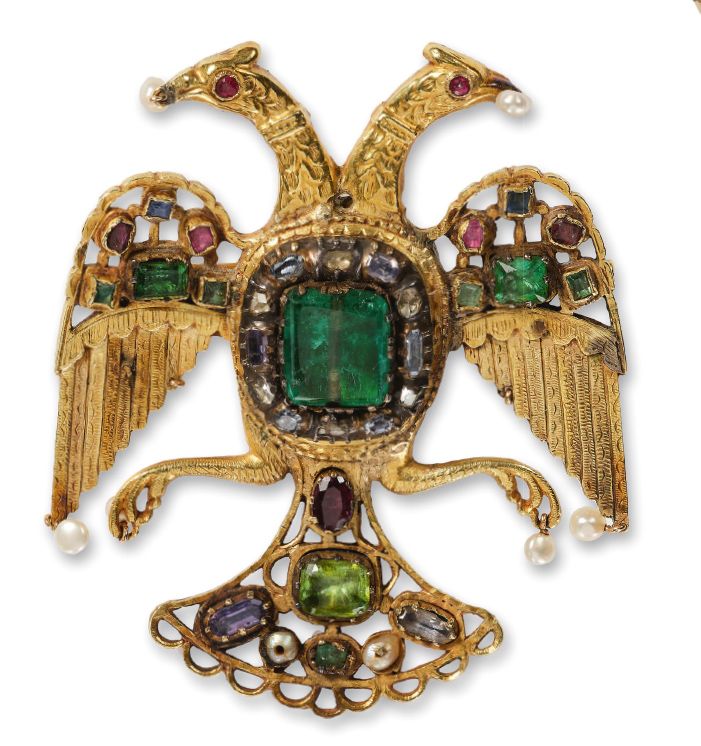Description
PECTORAL MEDAL "SERDOUK" in the form of a double-headed eagle, in yellow gold engraved and openwork on both sides, decorated with emeralds, sapphires, diamonds and rubies, decorated with pearls suspended from the beaks, talons and wings. Tunisia or Morocco, 18th century. Height: 8,5 cm - Width: 7 cm Gross weight: 67 g (mounted in brooch, missing a pearl) BIBLIOGRAPHY - Aviva Muller-Lancet, Dominique Champault, La vie juive au Maroc, éditions Stavit, 1986. - Paul Eudel, Dictionnaire des bijoux de l'Afrique du Nord : Maroc, Algérie, Tunisie, Tripolitaine, Ernest Leroux éditeur, Paris 1902. Birds are a very ancient element of Jewish iconography, as evidenced by the Bird's Head Haggadah, a fourteenth century manuscript and considered the oldest Ashkenazi illuminated Passover haggadah, now in the Israel Museum. This motif can also be found on embroidery and marriage contracts. More precisely, the double-headed bird motif was imported by Jewish jewelers in North Africa in reminiscence of Hispanic art. It is also found on various types of objects of Hebrew culture, both for cult furniture, such as an ornamental plate for the Torah (Inv.D.95.03.006.ACIP) or a Seder plate (Inv.D.96.04.029.MHL) preserved in the Museum of Jewish Art and History, and for jewelry. These objects, produced in the 18th century, come from both Spain and Germany. The similarity between this symbol and the famous double-headed bird of the Austro-Hungarian Empire can be seen. Nevertheless, according to Meyer Shapiro, the one does not exclude the other: "The two connotations of the eagle's head - representing the Jews as children of God and protected subjects of the emperor - are not incompatible. Two other medallions in the shape of a bird are preserved at the MAHJ, one with a head (Inv.D.2006.02.006), and the second, like ours, with two heads (Inv.D.2006.02.005).
96
PECTORAL MEDAL "SERDOUK" in the form of a double-headed eagle, in yellow gold engraved and openwork on both sides, decorated with emeralds, sapphires, diamonds and rubies, decorated with pearls suspended from the beaks, talons and wings. Tunisia or Morocco, 18th century. Height: 8,5 cm - Width: 7 cm Gross weight: 67 g (mounted in brooch, missing a pearl) BIBLIOGRAPHY - Aviva Muller-Lancet, Dominique Champault, La vie juive au Maroc, éditions Stavit, 1986. - Paul Eudel, Dictionnaire des bijoux de l'Afrique du Nord : Maroc, Algérie, Tunisie, Tripolitaine, Ernest Leroux éditeur, Paris 1902. Birds are a very ancient element of Jewish iconography, as evidenced by the Bird's Head Haggadah, a fourteenth century manuscript and considered the oldest Ashkenazi illuminated Passover haggadah, now in the Israel Museum. This motif can also be found on embroidery and marriage contracts. More precisely, the double-headed bird motif was imported by Jewish jewelers in North Africa in reminiscence of Hispanic art. It is also found on various types of objects of Hebrew culture, both for cult furniture, such as an ornamental plate for the Torah (Inv.D.95.03.006.ACIP) or a Seder plate (Inv.D.96.04.029.MHL) preserved in the Museum of Jewish Art and History, and for jewelry. These objects, produced in the 18th century, come from both Spain and Germany. The similarity between this symbol and the famous double-headed bird of the Austro-Hungarian Empire can be seen. Nevertheless, according to Meyer Shapiro, the one does not exclude the other: "The two connotations of the eagle's head - representing the Jews as children of God and protected subjects of the emperor - are not incompatible. Two other medallions in the shape of a bird are preserved at the MAHJ, one with a head (Inv.D.2006.02.006), and the second, like ours, with two heads (Inv.D.2006.02.005).
